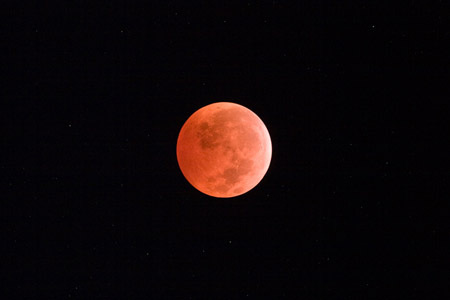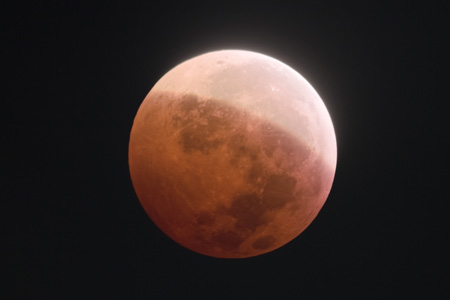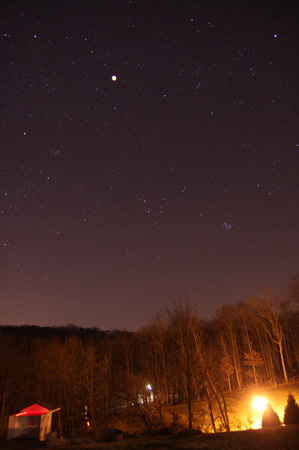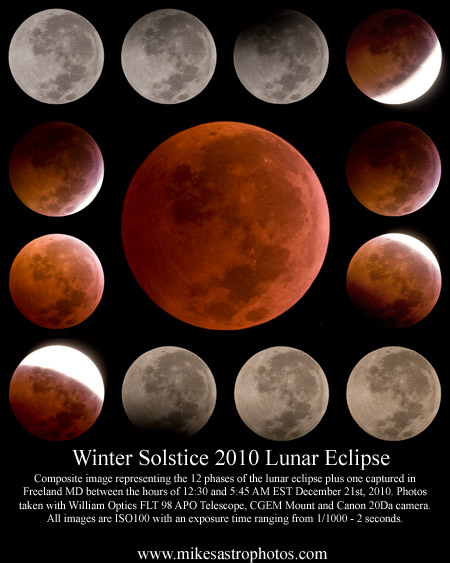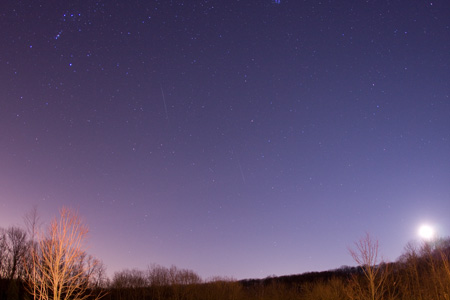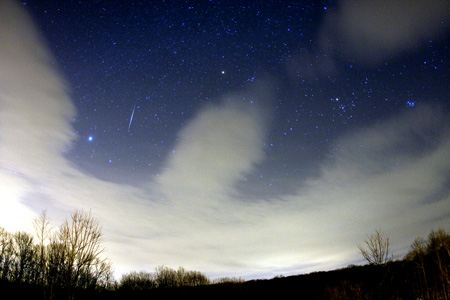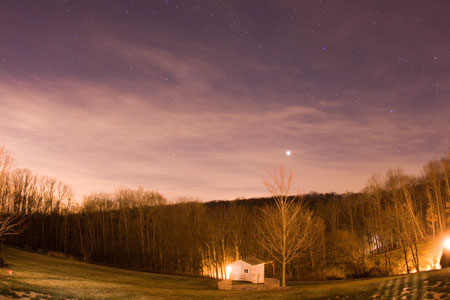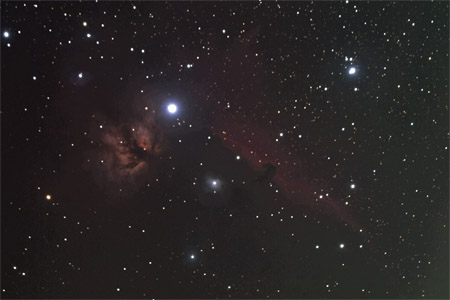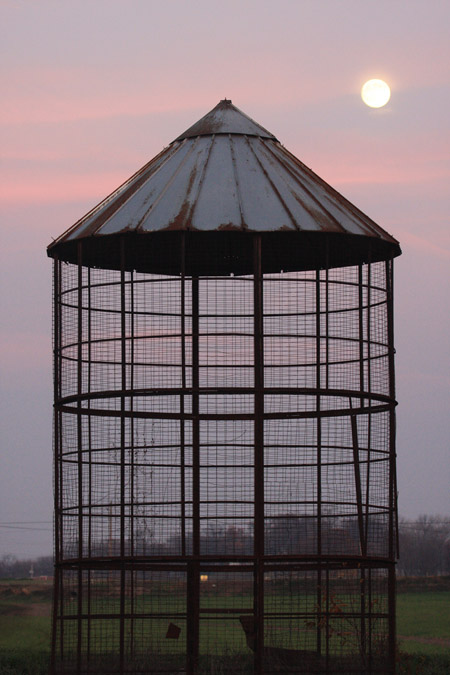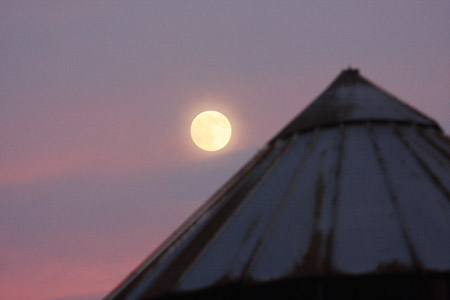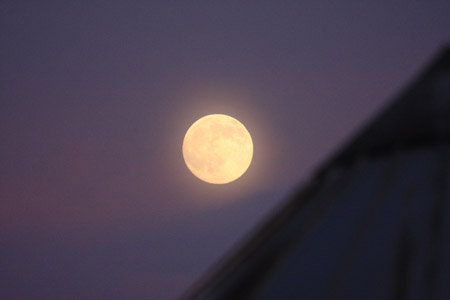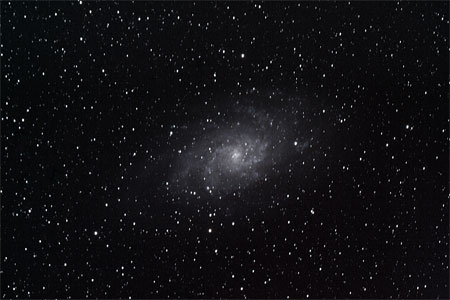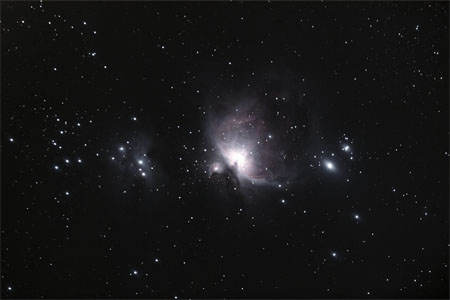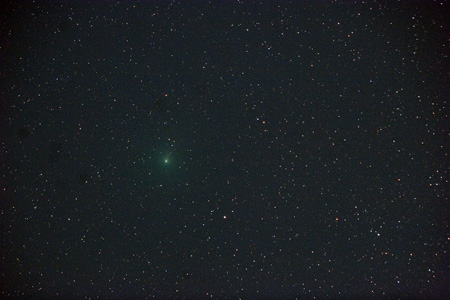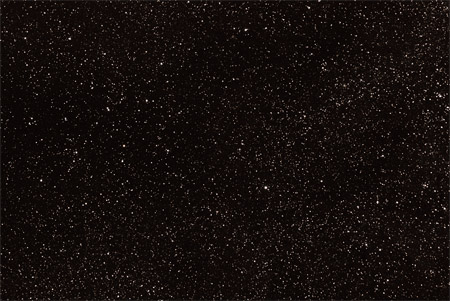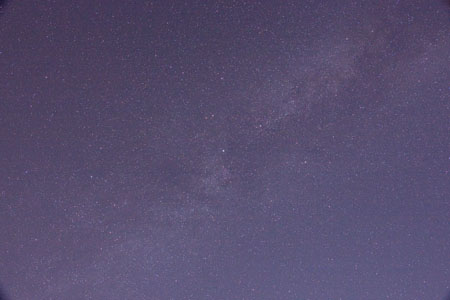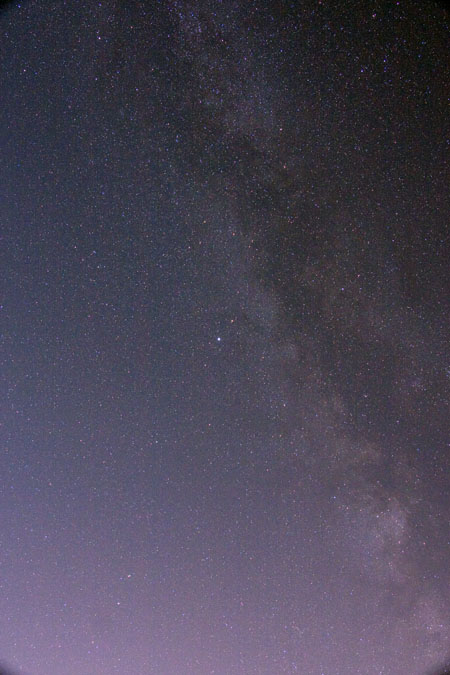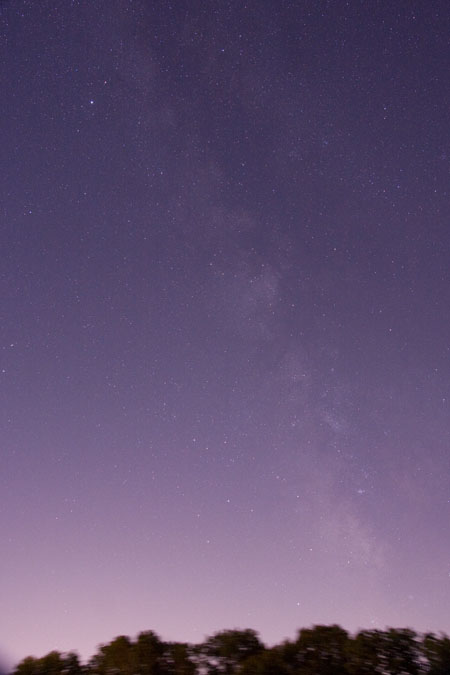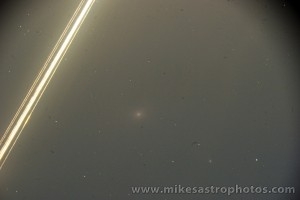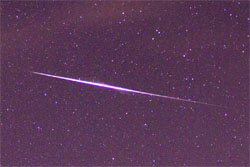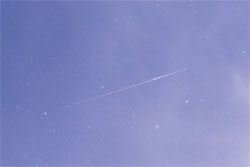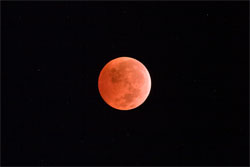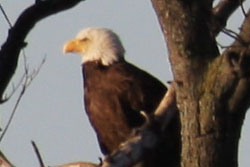Archive for 2010
December 28th, 2010 – Pennsylvania Fireball
by Mike Hankey, under Comets & Meteors
Reports are flying in regarding a fireball seen over Pennsylvania at 6:45 PM EST. Witnesses from South Carolina to Massachusetts are reporting a large bolide flying from south east to north west. Over 50 witness reports have been submitted to the AMS already. Early plotting suggests Michigan as the termination point. Will update on this event as more information becomes available. If you saw this fireball please report your sighting to the American Meteor Society Fireball Page.
Lunar Eclipse – December 21st, 2010
by Mike Hankey, under Lunar
Today was a special celestial day here on Earth. In addition to it being the winter solstice there was also a total lunar eclipse. These two events had not coincided together in 372 years. I had been looking forward to the eclipse for several months, hoping for good weather and planning out my strategy to photograph the event. Photographing eclipses and timing everything just right can get a little tricky and having never done it before, I wasn’t sure what to expect.
I started to research and quickly learned I would need to baby sit the camera through the entire process (a 5 hour tour). As the eclipse progresses and regresses, the moon significantly looses light and gains it back and thus the camera exposure times need to be adjusted throughout the night. I was able to find a nice chart that illustrated the formula to determine exposure times in a lunar eclipse. I also found a time schedule for the different phases. I used these two documents together as a guide for adjusting my exposures, starting out at 1/1000 of a second for the full moon and working my way up to 2 full seconds for the totally eclipsed moon. We had a few intermittent clouds through out the night, but they didn’t last long. All in all it was a perfect evening and I couldn’t have asked for more.
Here’s a nice photo of phase 9 of the tail end of the eclipse. Its a combination of two exposures, one short to capture the detail on the illuminated surface and another long to catch the red hue of the eclipsed side. Blending the two frames together ads definition to the bright part of the moon and makes an interesting effect.
I set up my second camera with the fish eye lens to photograph the evening, hoping we might get lucky and catch a meteor during the eclipse (that didn’t happen). It was really cool to see the difference in the sky when the moon was eclipsed.
The period of totality was calm, serene and surreal. It got so dark, the stars came out like a moonless night. At the end of the show I had a nice collection of images that documented the entire process. I had programmed my cable release to take a picture once every 20 seconds throughout the night and did this continuously from 12:30 – 5:45 am. I set alarms on my iphone to alert me with every phase change and at those points adjusted the exposure times up and down. I also had to periodically correct the tracking as my alignment wasn’t perfect and I wasn’t auto-guiding. There were times through the process where I would take multiple exposures, one short and one long. This would capture both the black gray and white red effects at the same phase of the eclipse. Both styles of these pictures are cool and both are available to the photographer throughout the process. If I had to do it over again I would have taken advantage of this more and manually switched the times more often.
I spent a good bit of time sifting through the images and thinking about the best way to present them. There are so many cool pictures throughout the entire process, but I can’t really post dozens of pictures on the site. I pulled out the key frames / phase change moments and went from there. I made an animated gif of the eclipse and thought about making a time lapse movie. Then this final design idea came to me, I sketched it out on a post-it note, liked the symmetry and wiped it together in photoshop. I think it might make a nice postcard.
Here’s a composite image representing the 12 phases of the lunar eclipse.
This was really a great experience and it worked out better than I could have hoped. There are a few improvements I will make in 2014, and I’m looking forward to it already.
Double Geminid
by Mike Hankey, under Comets & Meteors
Over 2 nights of mostly cloudy weather I was able to capture 21 total meteor photos (out of 2000+ images). One of these exposures caught two meteors within the same shot (a 25 second time frame).
Photo Details: Canon 40d camera with Canon EF 15mm f/2.8 fish eye lens; 25 second ISO 800 exposure
Geminids 2010
by Mike Hankey, under Comets & Meteors
The Geminid Meteor Shower peaked before dawn this morning and observers around the globe are reporting one of the best showings in years boasting rates of over 100 meteors per hour. The east coast and much of the country was under clouds and snow storms. I setup my camera while it was cloudy hoping conditions might change. Fortunately between 2:30-4 am the clouds cleared up a bit and in that 1.5 hours I photographed 13 meteors. Its cloud tonight, but I’m trying the same plan again. Here’s one of the photos from last night. I’m still processing the other pictures and will post more later.
Jupiter over Observatory
by Mike Hankey, under Planets
I got a new wide angle fish eye lens specifically for photographing the Geminids. The peak would be Tuesday morning and the weather report for Maryland looks like a whole lot of clouds the next few days. I was thinking about packing it all up and going for a road trip…
Here’s a shot through the new Canon EF 15mm f/2.8 fish eye lens. The big bright light over the observatory is Jupiter. I can capture more than 2x as much sky with this new lens compared to my next best meteor lens, hopefully that should lead to 2x as many meteor photos.
Geminid Meteor Shower This Week
by Mike Hankey, under Comets & Meteors
The Geminid Meteor Shower, one of the best showers of the year peaks this Tuesday right before dawn. If you have clear skys this weekend and over the next few days take time to look up for a few hours.
http://www.usatoday.com/tech/science/2010-12-10-geminid-shower_N.htm
The Horse Head Nebula
by Mike Hankey, under Nebula
The Horsehead Nebula is found on the left side of Orion’s Belt, near the star Alnitak. It is difficult to see with the naked eye through a telescope, but on a long exposure it can be a remarkable sight.
Photo Details:
William Optics FLT 98 / CGEM Mount
Canon 20Da Camera
SBIG STV Autoguider
20×5 minute ISO 400 exposures
Deep Sky Stacker
Photoshop cleanup
Beaver Moon in Lancaster
by Mike Hankey, under Lunar, Mason Dixon Meteor
The November full moon is known in the farmers almanac as the Beaver Moon. This was a signal to let people know to set their beaver traps before the creeks froze. The Full Beaver Moon also comes from the fact that beavers are actively preparing for winter at this time of year.
I caught some nice pictures of the Beaver Moon while meteorite hunting in Lancaster PA.
Reddit, Am I doing this right?
Breaking News: Fireball in Baltimore MD and York PA Nov 12, 2010 8:30 PM
by Mike Hankey, under Comets & Meteors
I was on my way home from meteorite hunting when I got a call from a neighbor in Freeland MD. He said he had just witnessed a huge fireball from the south-south-east headed to the north. The time was 8:30 on November 12th. He said it left a trail across the sky that stayed illuminated for several seconds after the meteor passed. It was bright enough to lighten the ground of the deck where he was standing. Based on his report it sounds like it would have started over Baltimore MD and ended in Harrisburg PA. I will post more information as it becomes available. Any witnesses to this event are encouraged to submit their account to the American Meteor Society Fireball Report.
M33 – Triangulum Galaxy
by Mike Hankey, under Galaxies
Approximately 3 million light years away in the constellation Triangulum is a spiral galaxy called The Triangulum Galaxy. Catalogued as Messier 33 or NGC 598,it is sometimes icalled the Pinwheel Galaxy, a nickname it shares with Messier 101. The Triangulum Galaxy is the third-largest member of the Local Group of galaxies, which includes the Milky Way Galaxy, the Andromeda Galaxy and about 30 other smaller galaxies.
Photo Details:
William Optics FLT 98 / CGEM Mount
Canon 20Da Camera
SBIG STV Autoguider
12×5 minute ISO 400 exposures
Deep Sky Stacker
Photoshop cleanup
M42 – The Great Orion Nebula
by Mike Hankey, under Nebula
Its that time of year again and Orion the hunter is currently rising in the east just before midnight. Orion is home to several spectacular nebula the most famous being M42 – The Great Orion Nebula. M42 is a defuse nebula situated just below Orion’s belt. Coming in at 24 light years across and only 1,344 light years away from Earth, the great nebula is big enough and bright enough to see with the naked eye, but without optics, its not much more than a smudge located in the center star of Orion’s sword. This diffuse nebula is one of the brightest nebula in the sky and a fantastic sight in binoculars or a small telescope. Here’s a recent picture of the nebula, much better than my first.
Photo Details:
William Optics FLT 98 / CGEM Mount
Canon 20Da Camera
SBIG STV Autoguider
12×3 minute ISO 400 exposures
Deep Sky Stacker
Photoshop cleanup
Comet Hartley 2 – 103P/Hartley
by Mike Hankey, under Comets & Meteors
Comet Hartley 2 was as close as it gets to Earth last week. I snapped these pictures the night after the peak (as peak night was cloudy.)
Here’s an animated GIF of a sequence of images taken over a 45 minute time period. Clouds were coming and going so I had to drop some frames at the beginning of the animation. The line that goes through one of the frames is a satellite.
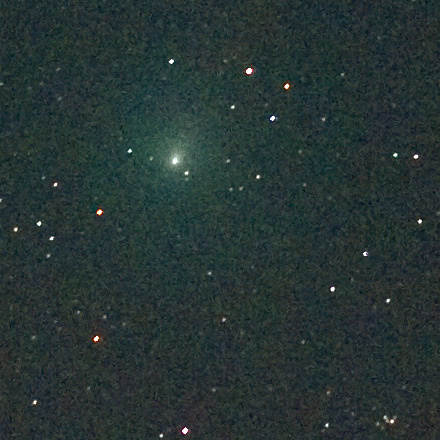
Comet Hartley 2 - Oct 22, 2010 16:26 - 17:17 UTC
The really really exciting thing about this comet is: NASA’s Jet Propulsion Laboratory is currently operating the EPOXI mission and one of the goals of this mission is to send a NASA probe (space ship) on a close fly by of this comet. This fly by is scheduled to take place in just a few days. You can read more about the EPOXI mission here.
Photo Details
William Optics FLT 98 / CGEM Mount
Canon 20Da Camera
No Auto Guider
30 second ISO 400 exposures
No stacking / no flat frame processing
minimal photoshop cleanup
UPDATE November 4th, 2010 From Gary Fujihara @ Big Kahuna Meteorites
For those of you who missed the live webcast, EPOXI spacecraft flew by Comet Hartley 2 a few minutes ago and took some absolutely stunning pictures with its Medium Resolution Imager. Here is a composite of 3 of the 5 closest approach images:
http://bigkahuna-meteorites.com/Images/CometHartley-04.jpg
And here is an Associated Press Story about the NASA mission.
Spiral Cluster
by Mike Hankey, under Stars
The Spiral Cluster, aka M34 is an open cluster in the constellation of Perseus found not far from the Perseus Double Cluster. M34 is an open cluster believed to have first been discovered by Giovanni Batista Hodierna sometime before 1654. In 1764 Charles Messier described it as
“a cluster of small stars between the head of Medusa and the left foot of Andromeda, a little below the parallel of gamma Andromedae. In an ordinary telescope of 3 foot [focal length] one can distinguish the stars.”
Photo Details
William Optics FLT 98 / CGEM Mount
Canon 20Da Camera
SBIG STV Auto Guider
24×3 minute ISO 400
Total Exposure Time: 1 hour 12 minutes
6 flat frames (av mode) & 1 dark
Most credible UFO story ever
by Mike Hankey, under Misc
So I heard about this story a few weeks ago. A bunch of retired US Air Force guys claim UFOs came to the nuclear missile silos in the US and remotely hacked our missiles and turned them off. These guys (over 100 of them) have recently met at a conference to discuss these events and the cover ups that followed. Here’s a video of the conference. This is pretty compelling stuff, not sure what to make of it. Comments welcome.
Summertime Milkyway
by Mike Hankey, under Stars
I took these milkyway photos this past July 4th, 2010. I mounted my DSLR and standard lens on top of my telescope, so that I could benefit from the mount’s tracking (and leave the shutter open longer to capture the milkway.) Each of these photos is a single 3 minute exposure @ ISO 800. I live in the suburbs, of the suburbs so it seems dark, but it is still considered an orange light pollution zone (just 2 notches down from the city). Surprisingly you can see the milkway quite well with your naked eye on a moonless summer night.
